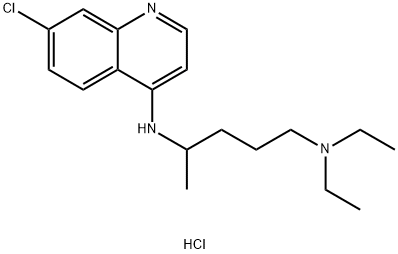盐酸氟西汀杂质
| 中文名称 | 盐酸氟西汀杂质 |
|---|---|
| 中文同义词 | 二盐酸氯奎因杂质;化合物 T0194L2;二盐酸盐氯喹;盐酸氯喹 |
| 英文名称 | N4-(7-chloro-4-quinolyl)-N1,N1-diethylpentane-1,4-diamine dihydrochloride |
| 英文同义词 | 1,4-Pentanediamine, N4-(7-chloro-4-quinolinyl)-N1,N1-diethyl-, dihydrochloride (9ci);4-((4-Amino-1-methylbutyl)amino)-7-chloroquinoline dihydrochloride;Aralen hydrochloride;Chloroquine dihydrochloride;Chloroquine HCl;Einecs 222-592-1;Quinoline, 4-((4-amino-1-methylbutyl)amino)-7-chloro-, dihydrochloride;Unii-nt0J0815S5 |
| CAS号 | 3545-67-3 |
| 分子式 | C18H28Cl3N3 |
| 分子量 | 392.79402 |
| EINECS号 | 2225921 |
| 相关类别 | |
| Mol文件 | 3545-67-3.mol |
| 结构式 |  |
盐酸氟西汀杂质 性质
|
HIV-1
|
Malaria
|
TLRs
|
SARS-COV-2
|
Chloroquine dihydrochloride (20 μM) inhibits IL-12p70 release and reduces Th1-priming capacity of activated human monocyte-derived Langerhans-like cells (MoLC). Chloroquine dihydrochloride (20 μM) enhances IL-1–induced IL-23 secretion in MoLC and subsequently increases IL-17A release by primed CD4+ T cells[1]. Chloroquine dihydrochloride (25 μM) suppresses MMP-9 mRNA expression in normoxia and hypoxia in parental MDA-MB-231 cells. Chloroquine dihydrochloride has cell-, dose- and hypoxia-dependent effects on MMP-2, MMP-9 and MMP-13 mRNA expression. TLR7 and TLR9 inhibition using IRS-954 or Chloroquine dihydrochloride significantly reduces HuH7 cell proliferation in vitro.
Chloroquine dihydrochloride (0.01-100 μM; 48 hours) potently blocked virus infection (vero E6 cells infected with SARS-CoV-2) at low-micromolar concentration (EC50=1.13 μM). Chloroquine dihydrochloride blocks virus infection by increasing endosomal pH required for virus/cell fusion, as well as interfering with the glycosylation of cellular receptors of SARS-CoV.
Chloroquine dihydrochloride (80 mg/kg, i.p.) does not prevent the growth of the triple-negative MDA-MB-231 cells with high or low TLR9 expression levels in the orthotopic mouse model.
TLR7 and TLR9 inhibition using IRS-954 or Chloroquine dihydrochloride significantly inhibits tumour growth in the mouse xenograft model. HCC development in the DEN/NMOR rat model is also significantly inhibited by Chloroquine.
安全信息
| 更新日期 | 产品编号 | 产品名称 | CAS号 | 包装 | 价格 |
|---|---|---|---|---|---|
| 2025/02/08 | HY-17589B | 盐酸氟西汀杂质 Chloroquine dihydrochloride | 3545-67-3 | 50 mg | 500元 |
